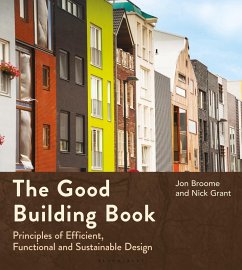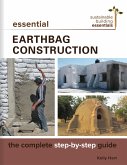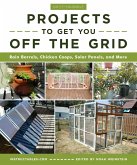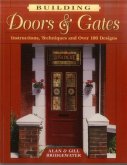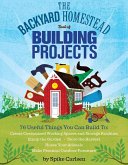Jon Broome, Nick Grant
The Good Building Book
Principles of Efficient, Functional and Sustainable Design
Versandkostenfrei innerhalb Deutschlands
29,99 €
inkl. MwSt.
Versandkostenfrei*
Erscheint vorauss. 27. Januar 2026
Melden Sie sich
hier
hier
für den Produktalarm an, um über die Verfügbarkeit des Produkts informiert zu werden.

15 °P sammeln
Jon Broome, Nick Grant
The Good Building Book
Principles of Efficient, Functional and Sustainable Design
- Broschiertes Buch
The Good Building Book reimagines design and construction for optimal performance and value while minimising environmental impacts.
Andere Kunden interessierten sich auch für
![Essential Earthbag Construction Essential Earthbag Construction]() Kelly HartEssential Earthbag Construction29,99 €
Kelly HartEssential Earthbag Construction29,99 €![Do-It-Yourself Projects to Get You Off the Grid Do-It-Yourself Projects to Get You Off the Grid]() Instructables ComDo-It-Yourself Projects to Get You Off the Grid15,99 €
Instructables ComDo-It-Yourself Projects to Get You Off the Grid15,99 €![Building Doors & Gates Building Doors & Gates]() Alan BridgewaterBuilding Doors & Gates22,99 €
Alan BridgewaterBuilding Doors & Gates22,99 €![The Backyard Homestead Book of Building Projects The Backyard Homestead Book of Building Projects]() Spike CarlsenThe Backyard Homestead Book of Building Projects20,99 €
Spike CarlsenThe Backyard Homestead Book of Building Projects20,99 €![Shipping Container Homes Shipping Container Homes]() Austin KnightShipping Container Homes12,99 €
Austin KnightShipping Container Homes12,99 €![Black + Decker the Complete Guide to Patios Black + Decker the Complete Guide to Patios]() Editors of Cool Springs PressBlack + Decker the Complete Guide to Patios21,99 €
Editors of Cool Springs PressBlack + Decker the Complete Guide to Patios21,99 €![Projects to Get You Off the Grid Projects to Get You Off the Grid]() Instructables ComProjects to Get You Off the Grid12,99 €
Instructables ComProjects to Get You Off the Grid12,99 €-
-
-
The Good Building Book reimagines design and construction for optimal performance and value while minimising environmental impacts.
Produktdetails
- Produktdetails
- Verlag: Bloomsbury USA
- Seitenzahl: 288
- Erscheinungstermin: 27. Januar 2026
- Englisch
- Abmessung: 235mm x 210mm x 25mm
- Gewicht: 454g
- ISBN-13: 9781399417136
- ISBN-10: 1399417134
- Artikelnr.: 72653595
- Herstellerkennzeichnung
- Libri GmbH
- Europaallee 1
- 36244 Bad Hersfeld
- gpsr@libri.de
- Verlag: Bloomsbury USA
- Seitenzahl: 288
- Erscheinungstermin: 27. Januar 2026
- Englisch
- Abmessung: 235mm x 210mm x 25mm
- Gewicht: 454g
- ISBN-13: 9781399417136
- ISBN-10: 1399417134
- Artikelnr.: 72653595
- Herstellerkennzeichnung
- Libri GmbH
- Europaallee 1
- 36244 Bad Hersfeld
- gpsr@libri.de
Jon Broome trained as an architect but is now a designer, enabler and self-builder. Previously Director of Architype, he now lives in London, where he runs his own consultancy specialising in sustainable construction. Nick Grant is a freelance energy consultant and principal of Elemental Solutions. One of the UK pioneers of Passivhaus Standard, he is an active contributor to discussions on sustainable design as well as a practical engineer and self builder.
Introduction
1.0 Design
1.1 What is a good building?
An introduction to the key principles of good buildings
1.2 Beauty, utility and economy in action
Archives and museums provide useful insight
1.3 Buildings as sculpture
When form overrides function to produce bad buildings
1.4 Eco-bling - innovation and aspiration
Aspiration and innovation can bring questionable results
1.5 Problem-solving designs
The features of a good building design process
1.6 The search for quality
What the designer must bring to the process - the need for care
1.7 A modern vernacular
Four principles coming together to shape a process for designing and
producing good buildings
1.8 The modern vernacular in action
Applying the four principles in action in the field of housing design
1.9 Self-build
Lessons from an approach to housing more akin to the idea of a modern
vernacular
1.10 Sustainable neighbourhoods
How the principles we have learnt from housing can inform good places,
towns and cities
2.0 Reducing energy
2.1 Comfort and sufficiency
Both important considerations, but what kind of 'comfort' and how much
space do we need?
2.2 Closing the performance gap
Why many buildings do not achieve their planned minimum-emission
performance
2.3 Form factor, massing and shape
How size and shape are often fixed before detailed cost, energy or
structural analysis are performed
2.4 Environmental modelling and targets
Numbers and targets are crucial to an understanding of how to improve the
performance of buildings
2.5 Passive solar design
Shifting the focus from passive solar gains to glazing design to serve the
comfort and of occupants
2.6 Why Passivhaus?
The benefits, limitations and myths surrounding the use of this highly
effective building standard
2.7 Buildings must breathe
Draught-free construction - and the resulting need for moisture and odour
control - are essential
3.0 Low environmental impact construction
3.1 Heavyweight or lightweight?
Advantages and disadvantages of both approaches and some myths explored
3.2 Upfront carbon emissions
How to reduce emissions arising from the act of construction, alongside
other environmental impacts
3.3 The more details, the more devils
Principles for detailing to create robust buildings that achieve design,
performance and sustainability aims
3.4 Elements of good building
Approaches to the design of foundations, raised ground-floor construction,
non-loadbearing walls, flat roof construction and windows
3.5 Services
Efficient building services should be integrated into the design from an
early stage
4.0 The business of building
4.1 Land
Focusing on the issue of land ownership and value, huge influencers on what
is built
4.2 Design education and post-occupancy evaluation
How to acquire the skills, knowledge and values designers need; learning
what works and what doesn't
4.3 Cost and value
Why do costs vary? Who benefits from value? How to reduce uncertainty and
control costs
4.4 Value engineering in design
Understanding how buildings perform and learning from experience
4.5 Appointing a design team and contractors
A constructive approach to finding the right team and managing costs,
quality and time
4.6 Risk management and regulation
Risks that cannot be avoided and how to mitigate them, and the uses and
limitations of regulation
Afterword
Notes on the authors
Chapter notes
Photo credits
Acknowledgements
Index
1.0 Design
1.1 What is a good building?
An introduction to the key principles of good buildings
1.2 Beauty, utility and economy in action
Archives and museums provide useful insight
1.3 Buildings as sculpture
When form overrides function to produce bad buildings
1.4 Eco-bling - innovation and aspiration
Aspiration and innovation can bring questionable results
1.5 Problem-solving designs
The features of a good building design process
1.6 The search for quality
What the designer must bring to the process - the need for care
1.7 A modern vernacular
Four principles coming together to shape a process for designing and
producing good buildings
1.8 The modern vernacular in action
Applying the four principles in action in the field of housing design
1.9 Self-build
Lessons from an approach to housing more akin to the idea of a modern
vernacular
1.10 Sustainable neighbourhoods
How the principles we have learnt from housing can inform good places,
towns and cities
2.0 Reducing energy
2.1 Comfort and sufficiency
Both important considerations, but what kind of 'comfort' and how much
space do we need?
2.2 Closing the performance gap
Why many buildings do not achieve their planned minimum-emission
performance
2.3 Form factor, massing and shape
How size and shape are often fixed before detailed cost, energy or
structural analysis are performed
2.4 Environmental modelling and targets
Numbers and targets are crucial to an understanding of how to improve the
performance of buildings
2.5 Passive solar design
Shifting the focus from passive solar gains to glazing design to serve the
comfort and of occupants
2.6 Why Passivhaus?
The benefits, limitations and myths surrounding the use of this highly
effective building standard
2.7 Buildings must breathe
Draught-free construction - and the resulting need for moisture and odour
control - are essential
3.0 Low environmental impact construction
3.1 Heavyweight or lightweight?
Advantages and disadvantages of both approaches and some myths explored
3.2 Upfront carbon emissions
How to reduce emissions arising from the act of construction, alongside
other environmental impacts
3.3 The more details, the more devils
Principles for detailing to create robust buildings that achieve design,
performance and sustainability aims
3.4 Elements of good building
Approaches to the design of foundations, raised ground-floor construction,
non-loadbearing walls, flat roof construction and windows
3.5 Services
Efficient building services should be integrated into the design from an
early stage
4.0 The business of building
4.1 Land
Focusing on the issue of land ownership and value, huge influencers on what
is built
4.2 Design education and post-occupancy evaluation
How to acquire the skills, knowledge and values designers need; learning
what works and what doesn't
4.3 Cost and value
Why do costs vary? Who benefits from value? How to reduce uncertainty and
control costs
4.4 Value engineering in design
Understanding how buildings perform and learning from experience
4.5 Appointing a design team and contractors
A constructive approach to finding the right team and managing costs,
quality and time
4.6 Risk management and regulation
Risks that cannot be avoided and how to mitigate them, and the uses and
limitations of regulation
Afterword
Notes on the authors
Chapter notes
Photo credits
Acknowledgements
Index
Introduction
1.0 Design
1.1 What is a good building?
An introduction to the key principles of good buildings
1.2 Beauty, utility and economy in action
Archives and museums provide useful insight
1.3 Buildings as sculpture
When form overrides function to produce bad buildings
1.4 Eco-bling - innovation and aspiration
Aspiration and innovation can bring questionable results
1.5 Problem-solving designs
The features of a good building design process
1.6 The search for quality
What the designer must bring to the process - the need for care
1.7 A modern vernacular
Four principles coming together to shape a process for designing and
producing good buildings
1.8 The modern vernacular in action
Applying the four principles in action in the field of housing design
1.9 Self-build
Lessons from an approach to housing more akin to the idea of a modern
vernacular
1.10 Sustainable neighbourhoods
How the principles we have learnt from housing can inform good places,
towns and cities
2.0 Reducing energy
2.1 Comfort and sufficiency
Both important considerations, but what kind of 'comfort' and how much
space do we need?
2.2 Closing the performance gap
Why many buildings do not achieve their planned minimum-emission
performance
2.3 Form factor, massing and shape
How size and shape are often fixed before detailed cost, energy or
structural analysis are performed
2.4 Environmental modelling and targets
Numbers and targets are crucial to an understanding of how to improve the
performance of buildings
2.5 Passive solar design
Shifting the focus from passive solar gains to glazing design to serve the
comfort and of occupants
2.6 Why Passivhaus?
The benefits, limitations and myths surrounding the use of this highly
effective building standard
2.7 Buildings must breathe
Draught-free construction - and the resulting need for moisture and odour
control - are essential
3.0 Low environmental impact construction
3.1 Heavyweight or lightweight?
Advantages and disadvantages of both approaches and some myths explored
3.2 Upfront carbon emissions
How to reduce emissions arising from the act of construction, alongside
other environmental impacts
3.3 The more details, the more devils
Principles for detailing to create robust buildings that achieve design,
performance and sustainability aims
3.4 Elements of good building
Approaches to the design of foundations, raised ground-floor construction,
non-loadbearing walls, flat roof construction and windows
3.5 Services
Efficient building services should be integrated into the design from an
early stage
4.0 The business of building
4.1 Land
Focusing on the issue of land ownership and value, huge influencers on what
is built
4.2 Design education and post-occupancy evaluation
How to acquire the skills, knowledge and values designers need; learning
what works and what doesn't
4.3 Cost and value
Why do costs vary? Who benefits from value? How to reduce uncertainty and
control costs
4.4 Value engineering in design
Understanding how buildings perform and learning from experience
4.5 Appointing a design team and contractors
A constructive approach to finding the right team and managing costs,
quality and time
4.6 Risk management and regulation
Risks that cannot be avoided and how to mitigate them, and the uses and
limitations of regulation
Afterword
Notes on the authors
Chapter notes
Photo credits
Acknowledgements
Index
1.0 Design
1.1 What is a good building?
An introduction to the key principles of good buildings
1.2 Beauty, utility and economy in action
Archives and museums provide useful insight
1.3 Buildings as sculpture
When form overrides function to produce bad buildings
1.4 Eco-bling - innovation and aspiration
Aspiration and innovation can bring questionable results
1.5 Problem-solving designs
The features of a good building design process
1.6 The search for quality
What the designer must bring to the process - the need for care
1.7 A modern vernacular
Four principles coming together to shape a process for designing and
producing good buildings
1.8 The modern vernacular in action
Applying the four principles in action in the field of housing design
1.9 Self-build
Lessons from an approach to housing more akin to the idea of a modern
vernacular
1.10 Sustainable neighbourhoods
How the principles we have learnt from housing can inform good places,
towns and cities
2.0 Reducing energy
2.1 Comfort and sufficiency
Both important considerations, but what kind of 'comfort' and how much
space do we need?
2.2 Closing the performance gap
Why many buildings do not achieve their planned minimum-emission
performance
2.3 Form factor, massing and shape
How size and shape are often fixed before detailed cost, energy or
structural analysis are performed
2.4 Environmental modelling and targets
Numbers and targets are crucial to an understanding of how to improve the
performance of buildings
2.5 Passive solar design
Shifting the focus from passive solar gains to glazing design to serve the
comfort and of occupants
2.6 Why Passivhaus?
The benefits, limitations and myths surrounding the use of this highly
effective building standard
2.7 Buildings must breathe
Draught-free construction - and the resulting need for moisture and odour
control - are essential
3.0 Low environmental impact construction
3.1 Heavyweight or lightweight?
Advantages and disadvantages of both approaches and some myths explored
3.2 Upfront carbon emissions
How to reduce emissions arising from the act of construction, alongside
other environmental impacts
3.3 The more details, the more devils
Principles for detailing to create robust buildings that achieve design,
performance and sustainability aims
3.4 Elements of good building
Approaches to the design of foundations, raised ground-floor construction,
non-loadbearing walls, flat roof construction and windows
3.5 Services
Efficient building services should be integrated into the design from an
early stage
4.0 The business of building
4.1 Land
Focusing on the issue of land ownership and value, huge influencers on what
is built
4.2 Design education and post-occupancy evaluation
How to acquire the skills, knowledge and values designers need; learning
what works and what doesn't
4.3 Cost and value
Why do costs vary? Who benefits from value? How to reduce uncertainty and
control costs
4.4 Value engineering in design
Understanding how buildings perform and learning from experience
4.5 Appointing a design team and contractors
A constructive approach to finding the right team and managing costs,
quality and time
4.6 Risk management and regulation
Risks that cannot be avoided and how to mitigate them, and the uses and
limitations of regulation
Afterword
Notes on the authors
Chapter notes
Photo credits
Acknowledgements
Index
